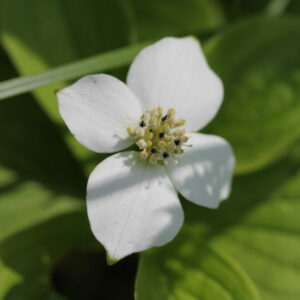
Family: Cornaceae/ Dogwood
Ecology/ Botany:
This shade-loving, creeping perennial is usually beneath the canopy of mature coniferous forests amongst the decaying wood. It will blanket the ground when well established. The little bunches of sweet, pulpy berries are edible. It is not a true flower and has an explosive pollination mechanism. It is widespread and prefers to grow in cool, moist to wet climatic regions in Sub- Boreal Spruce and Interior Cedar Hemlock forest zones from low to subalpine elevations.
Medicinal/ Other Uses:
The whole plant has pain-relieving and anti-inflammatory properties that have been used to treat headaches and fevers and to support the digestive tract. The berries have been used internally or topically and may even reduce the potency of poisons. They also have been used to soothe irritations like burns or bug bites. Lower St’at’imc (Lillooet) and Coastal Salish people know this plant as having edible berries, but most BC Interior Indigenous people do not consider them edible, and some nations consider them poisonous.
References/ Other useful links:
E-FLORA BC: ELECTRONIC ATLAS OF THE FLORA OF BRITISH COLUMBIA
Native American Ethnobotany DB
Parish, Coupe, Lloyd. 1996. Plants of Southern Interior British Columbia. B. C. Ministry of Forests and Lone Pine Publishing.



